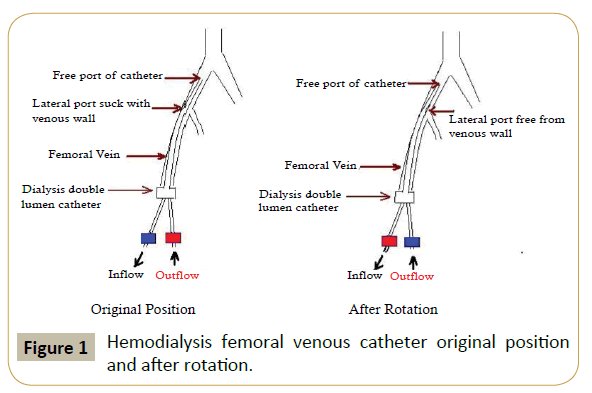Monish S Raut* and Arun Maheshwari
Department of Cardiac Anesthesiology, Sir Ganga Ram Hospital, New Delhi, India
- *Corresponding Author:
- Monish S Raut
MD, FNB, Department of cardiac anesthesiology
Sir Ganga Ram Hospital, New Delhi, India
E-mail: drmonishraut@gmail.com
Received Date: July 30, 2016; Accepted Date: August 09, 2016; Published Date: August 16, 2016
Citation: Raut MS, Maheshwari A. Dialysis Catheter in Femoral Vein. J Intensive & Crit Care 2016, 2:3.
Introduction
Hemodialysis is important part of management in patients with severe metabolic acidosis and hyperkalemia. Central venous insertion of dialysis catheter in femoral vein and internal jugular vein is commonly performed. Efficacy of dialysis depends on proper inflow and outflow of blood through dialysis catheter. Inadequate free flow in one port of dialysis catheter does not always mean blockage of the catheter. We need to know anatomical course of the vein to understand the mechanism of inadequate flow.
Case
58 year old lady was admitted in intensive care unit with cardiogenic shock and severe metabolic acidosis. In view of anuria and progressive acidosis, it was decided to perform hemodialysis. Under all aseptic precautions, left femoral vein was punctured and double lumen dialysis catheter was inserted. Back flow could be easily aspirated in one lumen but not in other; however saline was easily flushed in through both lumens without resistance. As the dialysis machine inflow and outflow tubes were connected to the two ports of catheter, blood could not be aspirated through outflow tube. Catheter was little pulled out and any mechanical kinking at insertion site was ruled out, however no free flow in aspiration was observed. Finally catheter was rotated by 180 degrees before considering other vein for catheter insertion. Blood could be easily aspirated through both lumens after rotating the catheter. Dialysis was started without any problem in inflow and outflow.
Discussion
Central venous hemodialysis catheters reduce cardiopulmonary recirculation. Dialysis adequacy is influenced by catheter position. Kinking of the catheter generally causes increased resistance to flow. Studies have emphasized positioning of the venous dialysis catheter in determining catheter survival and adequacy of flow [1]. Catheter-related problems commonly encountered are infections and catheter thrombosis [2,3]. Dysfunction of hemodialysis catheter is the inability to aspirate blood or inability to deliver an adequate dialysis prescription, blood flow rate <300 mL/min, and increased arterial or venous pressure [4,5]. In the present case, side hole of the catheter might have got stuck to the venous wall due to suction effect as the blood was tried to aspirate through its lumen. When the catheter was rotated by 180 degree, adequate space might have been present to abolish suction induced sticking effect of catheter (Figure 1).
Figure 1: Hemodialysis femoral venous catheter original position and after rotation.
Conclusion
We suggest the manoeuvres like slight pulling back or rotation of the catheter, checking for kinking at the insertion site. These manoeuvres should be tried in situations with inadequate flow in dialysis lumen catheter before considering the placement at other site.
References
- Andrew D (2000) Central venous catheters for hemodialysis: How to overcome the problems. Hemodial Int4:78-82.
- Kairaitis LK, Gottlieb T (1999) Outcome and complications of temporary hemodialysis catheters. Nephrol Dial Transplant 14:1710-1714.
- Suhocki PV, Conlon PJ, Knelson MH, Harland R, Schwab SJ (1996) Silastic cuffed catheters for hemodialysis vascular access: Thrombolytic and mechanical correction of malfunction. Am J Kidney Dis 28:379-386.
- Kamper L, Piroth W, Haage P (2010) Endovascular treatment of dysfunctional hemodialysis catheters. J Vasc Access 11:263-268.
- Moist LM, Hemmelgarn BR, Lok CE (2006) Relationship between blood flow in central venous catheters and hemodialysis adequacy. Clin J Am Soc Nephrol 1:965-971.


